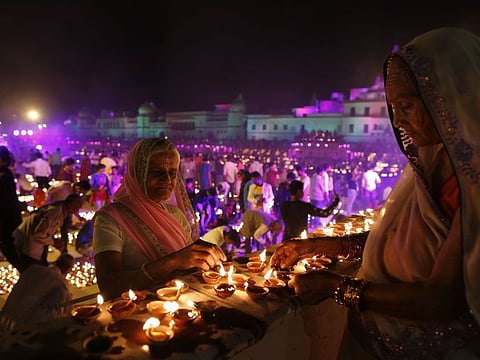A quiet affair this year
Diwali 2019 has been a collective effort and good change from previous years

It has been after a long time that we had a practically noise and smoke-free Diwali preceded by Dussehra in India this month. This was made possible thanks to the growing awareness about the menace of pollution that has, over the years, engulfed the entire nation.
For many people, 2019 was ‘different’ and quieter. But for people my age, it was revisiting my childhood. The focus used to be on de-cluttering the house, cleansing it thoroughly with water and decorate the house with earthen lamps. There was no system of lighting the candles, either.
I still remember how we got gifts in the form of new clothes and tonnes of freshly made savouries and curries. We ate mind-boggling varieties of sweets and snacks throughout the week preceding and following it. The spirit of the festival was essentially to welcome the new lot of fresh vegetables, rice and fruits that marked the end of the monsoon season.
Unlike today, there were no marketing gimmicks to promote the Festival of Lights. It was a simple affair with mostly homemade food eaten together with the entire family.
Coming back to 2019, on Dussehra, ordinarily, the burning of the colourful and towering effigies of Ravan, Kumbhakaran and Meghnaad accompanied a lot of noise and smoke. But this year, in one of the main Ramlilas in New Delhi, they played recorded sounds of cracker explosions — a novel idea that bypassed the actual burning of the effigies loaded with crackers. The smoke and eventual pollution were much less. This was a welcome phenomenon.
It must have disappointed many youngsters but thankfully, better sense has prevailed as the new generation is increasingly becoming aware of the disastrous perils of pollution. Thanks to their increased exposure to social media and television, they are seeing for themselves, how the resultant global warming has severely disturbed the cycle of seasons.
Diwali was a collective effort in which even corporate companies came up with ads to encourage children to gift saplings this year instead to secure a green future for the next generation. Some others promoted the much-overlooked potter’s handmade earthen diyas (lamps).Lalit Raizada
Never before have we experienced heavy rains that flooded even the Thar desert of Rajasthan and areas that perpetually faced droughts. Many in India were puzzled last year to know about snowfall in some parts of the UAE and Saudi Arabia, and untimely hailstorms and rains in the desert region.
Yes, some youngsters did sneak out with crackers with high decibels on Diwali, but fortunately, a considerable section of environment-conscious people drove some sense into their minds and encouraged them to go back to nature. While many used candles and strings of colourful electric lights, there were people who opted for earthen lamps with cotton wicks soaked in ghee (clarified butter) or mustard oil.
This was another nudge to go back to the tradition from the time of Ramayana when King Ram was welcomed back with his wife Sita and brother Lakshman to Ayodhya after an exile of 14 years. Mythology says, the poor welcomed them back by lighting these diyas in mustard oil.
In my opinion, this Diwali was a collective effort in which even corporate companies came up with ads to encourage children to gift saplings this year instead to secure a green future for the next generation. Some others promoted the much-overlooked potter’s handmade earthen diyas (lamps).
In a parallel campaign run across schools nationwide, there was an awareness raised about birds dying due to crackers and street animals getting scared and scarred due to the noise and smoke caused by firecrackers.
I feel this is a good change that has influenced young minds and will perhaps reverse the damage done to the environment. It is gratifying that the message has taken deep roots.
—Lalit Raizada is a senior journalist based in India.
Sign up for the Daily Briefing
Get the latest news and updates straight to your inbox



